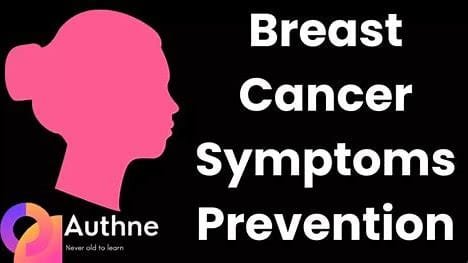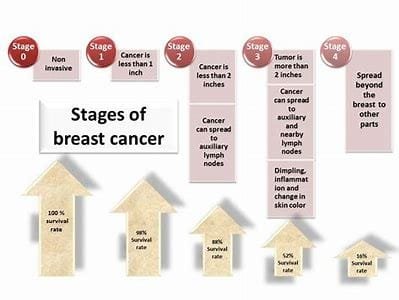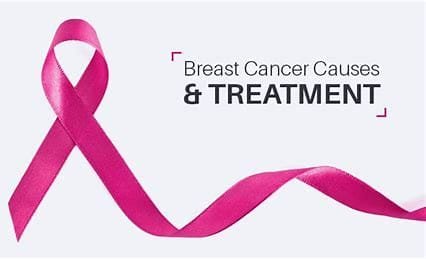Breast cancer is one of the most common cancers diagnosed in women all over the world. It is also diagnosed in men, although not as often. Early detection of breast cancer has a lot to do with determining treatment outcomes.

Causes of Breast Cancer
Breast cancer is the result of uncontrolled growth of cells in the breast. In most cases, these cells grow and form a tumor that is palpable or sometimes evident on imaging scans. Though the causes of breast cancer are not well known, there are some factors known to increase the risk.
Genetics and Family History: When there is a history of breast cancer in your family, especially if you have a first-degree relative who is your mother, sister, or daughter, your risk is higher. If you have an inherited mutation, especially in the BRCA1 and BRCA2 genes, your risk skyrockets.
Age: The older you are, the more at risk you are to get breast cancer. In most cases, it develops after age 50.
Hormonal Factors: A long exposure to estrogen may be due to early menarche, late menopause, or hormone replacement therapy (HRT), among other factors.
Lifestyle Factors: Smoking, alcohol, a sedentary lifestyle, and obesity are well known. Diets with higher intakes of processed foods and lower intakes of vegetables and fruits also are considered contributing factors.
Environmental Exposure: Some chemicals, particularly hormone-like chemicals, can affect the risk of breast cancer. More extensive exposure to radiation may also be considered a cause, including exposure to radiation therapy on the chest.
Symptoms of Breast Cancer
Breast cancer symptoms are varied and may not be evident at all times. Some of the common symptoms of breast cancer include the following:
Lump or Thickening: Any new lump in the breast or underarm is one of the first signs and quite painless. Not all lumps are cancerous but ought to be assessed by a health care provider.
Size or Shape Change: In addition, any noticeable difference in the size, contour, or shape of the breast could indicate a problem, particularly if it affects only one breast.
Changes in skin: Swelling, redness, or dimpling (skin looks like orange peel) may indicate there is some cancer within your breast. Peeling, scaling, or crusting skin, particularly around the areola, may also present.
Nipple changes: A change in appearance, such as inversion or discharge—especially bloody—should prompt a healthcare provider’s exam.
Pain in the breast: Much less common, others report a chronic ache in the breast or armpit that does not relate to their menstrual cycle.
Treatments for Breast Cancer
Depending on the type, the stage of the cancer, and the overall health of the patient, the treatment given for breast cancer will depend. More often than not, the best results often come from a multidisciplinary approach where a series of treatments are used.
The initial therapy: in which cancer tissue is removed. It might be as minimal as performing a lumpectomy—by removing just the tumor as well as its surrounding tissues—or as invasive as executing a mastectomy by deleting the entire breast.
It destroys any cancerous tissues that remain within the affected breast region following the execution of surgery. This happens during radiation therapy by hitting targeted cancer cells with powerful X-rays, reducing the prospect of recurrence.
Chemotherapy: is advised when the cancer is advanced or of aggressive nature. It contains chemicals that kill the cancerous cells but, in doing so, may destroy the healthy cells also, which leads to side effects.
Hormone Therapy: For cancers that are positive for hormone receptors, hormone therapy can prevent or reduce the estrogen in the body, thereby slowing down the proliferation of cancerous cells.
Targeted Therapy: The drugs or other agents specifically target cancer cells without touching normal cells, and the effects are relatively minimal as compared to chemotherapy.
Immunotherapy: This stimulates the body’s immune system to fight cancerous cells. Most of this treatment is reserved for a particular kind of breast cancer, like triple-negative breast cancer.
Disadvantages and Life Impact of Breast Cancer

Generally speaking, having breast cancer involves a much broader implication concerning a man’s physical and emotional aspects in all respects of human life—a family and, most so, society as well. Thus, among others, maybe some of its disadvantages encompass the following concerns:
Physical side effects: Obviously, treatments such as surgery, chemotherapy, and radiation have side effects that include possibly fatigue, hair loss, nausea, swelling due to lymph node removal, and skin changes, all of which may decrease a person’s quality of life during and after the treatment.
Mental Health: The diagnosis is frightening, anxiety-provoking, and depressing as well. Treatment over years, combined with fear of recurrence, makes it psychologically challenging to overcome the disorders.
Social Impact: Familiar relations with family and friends, as well as partners, are changed once patients and their caregivers transform into new roles and accept new responsibilities. Social exclusion may become a common result if the patients feel isolation or miscommunication.
Financial Burden: The cost of treatment might be high, even if covered by insurance, thus creating financial stress. The necessity for continued care and follow-ups adds to this burden, which can have a ripple effect on the family’s economic stability.
Changes in Body Image and Self-Esteem: Since mastectomy is a part of many breast cancer treatments, a lot of body image changes are expected. Loss of a breast, scars left by it, or hair loss are some of the factors that can deter a woman’s confidence and self-identity, which often leads to social withdrawal.
Work and daily life: This may need time off at work or even a change of job if the disease and treatment interfere with their ability at work. This may interfere with financial stability and other career choices.
Conclusion


Although still a difficult disease, the far-reaching effects of breast cancer have not hindered early detection or improved treatment that greatly enhances survival and quality of life. Symptoms and risks can teach a person to seek attention when first signs appear, but emotional and physical healing through continued support from friends, family, and medical care is essential.



